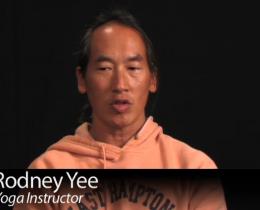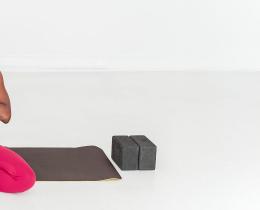Omega: B.K.S. Iyengar is one of the most influential yogis in the West to date. You’ve studied with B.K.S. Iyengar and practiced his style of yoga for more than 45 years. What is it like to have worked in the same practice for so long?
Joan: I found that the depth of Iyengar Yoga was something I could commit to. When I started to study it, I began to understand what a huge subject yoga really is. Here was a man who had tremendous depth and experience, yet he was always learning new things and exploring.
Practicing Iyengar Yoga has made me a much stronger individual. I’m stronger in my convictions and more able to stand up to the world and live in the world with more fearlessness. It’s also taught me that things change. I’m a person that tends to not like change, but yoga has taught me to be prepared for change. It’s also helped me heal from a number of very severe physical injuries—including a broken back and renal failure. If I didn’t have yoga, I’m not sure where I’d be now.
Omega: What in particular did you like about his teaching style?
Joan: I’ve always been interested in communication and teaching styles. His methodology was to take people from the known to the unknown—from something they could identify with to something more esoteric. He would start with the body, with an instruction everyone could understand. He said everybody had a body and so that would be the place to start.
For example, if he was talking about the foot, he would talk about exactly where to press down on the foot, like the mound of the big toe. He would use that as a jumping off point to work you into something that was much more difficult to feel. The class might have people at the very beginner level and people who have more experience, but by the end of his teaching that asana, everybody was on a similar plane. Not that everybody could do it as well as the next person, but everybody was working on the same aspects of the asana.
Omega: What distinguishes Iyengar Yoga from other styles of yoga?
Joan: It was Mr. Iyengar (Guruji) himself that distinguished Iyengar Yoga from other styles. He was an extraordinary practitioner. He never stopped practicing. He was inventive until the end and didn’t rely on anybody else but himself to develop what he did.
His body was his testing ground and his laboratory. What also made him unique was his ability to understand and help somebody in a flash. He could read a body and interpret what he saw. His powers of observation were unbelievable. He could correct you one way in one moment and then two seconds later turn around and give you a different correction if you needed it.
His mind was like a computer. He put together patterns in the bodies that he observed with patterns of health issues and eventually had an encyclopedic knowledge of what happens in the body. He would look at people with, say, hip problems and know something about their issue and how it relates to them being tall or short or long-waisted or short-waisted.
Omega: What was Mr. Iyengar like as a person?
Joan: He was a very practical person and taught in a very logical and rational way. He didn’t believe in keeping things a mystery. He was also a simple person in many ways. He grew up in an extremely impoverished home. His father passed away when he was very young. He didn’t have a chance to have much of an education, so he was self-educated. He spoke about eight languages, and he always worked on his English. He never claimed to know it all—he only claimed to know the yoga that he experienced.
Omega: Iyengar Yoga has a reputation of being very precise and alignment-based. Would he have framed it that way?
Joan: Those things are true but not exact. He wouldn’t understand the idea of "alignment yoga." He didn’t see yoga the way the Western person thinks he did. He was much more interested in subtle alignment and the movement of prana, or subtle energy, in the body.
He went through various phases in his practice. When he started reading the texts, he realized that he wasn’t experiencing the kinds of things that were being described. To discover why he wasn’t having these transformations in his pranic energy, he began to focus on how he was doing things—on the act of movement.
His intention, which has been misunderstood by most people who are not his close students, was not about just aligning the foot and the shin and the knee and the thigh, for instance. It was about what happens if you do that. What’s the result? And if you did that, would it take you to a deeper level of understanding or awakening? He explored alignment from the perspective of subtle anatomy.
Guruji didn’t start out knowing a lot about physical anatomy. He learned about anatomy over time and always had at least one doctor around him that he was teaching or training and whom he could ask questions of. He would consult with them about what his observations were and ask about the medical side of something, but ultimately, for him it was about integration. He was always challenging us to figure out if you move your foot this way, what happens elsewhere in the body? How does it clear or obstruct the channels of subtle movement?
Omega: How did his teaching change over time?
Joan: In the beginning, he didn’t bring a lot of philosophy into yoga. He was teaching in London and had been told by the people there that they didn’t want any Indian philosophy brought into the classes. In some parts of the United States it wasn’t wanted either. But over time, especially by the time he was in his late 80s, he began to bring the Yoga Sutras in, then later the Bhagavad Gita. His children—Prashant, Geeta, and Sunita—have brought a great deal of philosophy from other yoga texts into his teachings.
Omega: What do you think was his most important legacy?
Joan: His biggest legacy is that he spread yoga to the West. I’d say 98 percent of the yoga happening here today stems from his work. He was also the first one to teach men and women in the same class. It was forbidden for him to do that in India when he started. He was a Brahman and Brahmans weren’t supposed to touch those who are not also Brahmans, so he broke through a whole lot of taboos in his teaching.
Another important legacy is that anyone can do yoga if they want to, whether they’re healthy or unhealthy. He was sometimes called “the furniture yogi” because of all the props he used and developed for people, but he did it to help people modify the asanas for their benefit.
Omega: What’s one of the most enduring lessons you learned from Mr. Iyengar?
Joan: He taught us a lot about compassion, but I didn’t understand it when I was younger. The more I studied with him and the more I watched him, the more I started to understand what compassion was and how you could work with it as a teacher.
For instance, if you have a class with mixed ages, you don’t just assume you should pamper someone who is elderly. You also don’t assume the reverse about those who are young. An old person could be really flexible and a young person could be stiff. He taught us to bring a uniformity to the class, in each asana. He showed us how to have everyone working along the same lines so everyone can fulfill their potential, no matter what level they’re on. That’s teaching with compassion.



